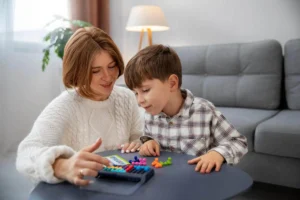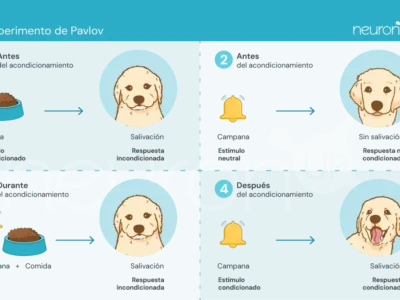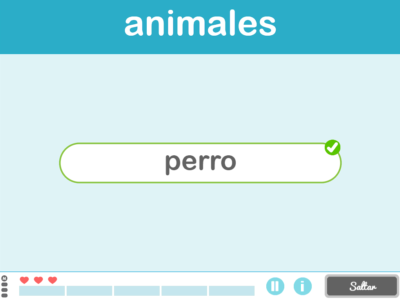Educational psychologist Irma Fernández tells us about the challenge that living a life with autism represents for the person affected, but also for those around them.
Life per se is a challenge, living with autism amplifies that challenge. The context, for people who go through life with autism, can act as either a barrier or a bridge when facing day-to-day life.
Caregivers of people who require very significant support, significant support and support, (DSMV) could promote basic matters in them such as self-determination and relieve the burden of always deciding for them, validate their personality and work on executive functions to achieve better adaptation to the world.
Life with a person with autism
Family and caregivers play a crucial role in the life of a person with autism.
Parents, siblings and caregivers
Every person, as a child, needs love and respect to help them better understand the world, be alert and be aware. Understanding the world is not easy. Trying to understand the truth according to “someone” is complicated, we need help to grasp an idea and even more when it is foreign to habitual thoughts.
Living life with autism has a double task, but transforming thinking and abandoning false beliefs takes time. However, for the good of everyone, becoming more flexible in our thinking can help improve the life of the person with autism.
This ability usually appears in childhood; nonetheless, as adults it needs to be strengthened to stop expecting that a person with autism must “rehabilitate” and be brought closer to the norm.
The dynamic of each family is unique, like fingerprints.
Parents
Parents who validate life with autism recognize in the individual their personality, desires and needs like anyone else, allow them to make decisions from an early age about basic matters, according to their abilities such as:
- take the fruit that mom or dad offers them,
- choose the t-shirt to wear,
- play with water or dough,
This contributes to shaping their character. This is a demonstration of respect for life with autism.
Siblings
Siblings who are older than the one living with autism may seem to find an opportunity to feel relieved of parental surveillance since all attention is directed to the younger child, and when they are younger, they frequently come to feel emotionally abandoned.
Parents must find a balance in attention for all family members. For the person living with autism, the presence of siblings, in the best of cases, is a great strength, since the bond that unites them provides unique experiences of brotherhood, respect, diversity and learning that are valued over time.
Caregivers
Caregivers of people with autism who require very significant support have knowledge about the life with autism. It must be so since the pragmatics that life itself demands goes beyond theory.
Peculiarities are discussed in five areas of development, deficiencies in theory of mind, central coherence and in executive functions. All this represents a real challenge to achieve what has been proposed regardless of the level of support the person requires.

Subscribe
to our
Newsletter
The person living with autism
For anyone it can be difficult to understand the good intentions of parents. Although the supreme interest encompasses adaptation, health, education, well-being, inclusion, etc., it is not possible to achieve it right away.
The mind of someone living with autism is characterized by being inflexible, having deep interests, sensory, social, communication and behavioral peculiarities while always needing to experience situations full of opportunities for participation.
As is evident, life with autism demands constant attention, which can be extended over time because social behavior does not exist in the same way forever; it changes all the time depending on the context.
Well-being is a broad term, which is not hard to reach if we rely on visual resources such as agendas, calendars, and anything that structures the environment and functions as a predictor of what is about to happen, since part of our brain remains calm when it feels safe.
With these supports life with autism is lived with less anxiety by knowing in advance that the routine of visiting grandmother every Friday has changed due to the rain forecast and instead she comes to the house on Thursday so everything will be fine.
Health as a source of happiness
Spontaneity
Living life spontaneously brings enormous happiness to many; however, life with autism requires controlling that spontaneity. Therefore, it is advisable to start by knowing the person’s sensory profile, focusing our attention on processing the eight senses known so far.
Food
Discovering the hyper or hypo reactivity to sensory stimuli through sight, hearing, touch, taste, smell, proprioceptive, vestibular and interoceptive senses will to some extent make it possible to maintain and/or safeguard their health. For example, offering natural foods (to which they are not intolerant) free of sugar, preservatives, gluten and casein that not only feed them but also nourish them will be fundamental.
We are what we eat and what we eat influences behavior, sleep quality and, therefore, skill acquisition. For someone living with autism this aspect can be truly complicated if they present leaky gut, since the consumption of certain foods acts like an opiate causing highly disruptive behaviors.
By creating an adequate environment the degree of irritability decreases, so regulating noises or flashes of light, using a certain tone of voice, minding scents, containing them, and providing a safe space will maintain the willingness of the person living with autism to interact.
Friendly environment
Life with autism is lived by a human being and it is absolutely necessary that the environment be as friendly as possible while strengthening their mental flexibility, which will provide them with adaptation skills gradually.
The role of education in the life of the person with autism
Education is a whole subject. It starts at home and continues at school. Inclusion begins precisely at home by accepting and understanding the condition, by making the necessary adaptations starting with the ideals of all those who coexist in life with autism, providing the person with security and affection and also with skills that are fundamental to attend school.
School for a child with autism
School offers many opportunities to everyone and its sensitive, nonjudgmental intervention with great respect for diversity is expected. The brain is a social organ that requires the group to develop and learn.
A person living with autism enjoys the same rights and is subject to the same obligations as everyone. It is by being at school that the right to increase experiences and opportunities for participation is exercised. School is an excellent means of learning.
Once at school what is expected is that the person living with autism adapts and for that, executive functions play a very important role. A brain capable of solving spontaneous situations also sets emotional processes in motion.
Adapting to a life with autism
Adaptation entails a whole set of skills and for someone living with autism it implies a great challenge. It is advisable to develop and/or strengthen them one by one as needed. Play is an excellent way of learning and it activates these skills.
Living with autism can be exhausting because one is subjected to expectations that are often unattainable, such as “functioning” neurotypically. There is tension from not knowing the rules of coexistence outside life with autism.
Autism is present in the world, although the world is not made for it; however, by sharing the same plane, the degree of adaptation of each should be reasonably proportional.
Conclusions
It is not possible to separate autism from the person if they are destined for a life with autism. Culture through values is what defines human competencies. Studies provide forms, means and resources to bring people living with autism closer to what the majority (called society) expects.
The invitation to society is to thoroughly know the condition, adhere to universal design when creating recreational, school, work, medical, etc., spaces that facilitate the inclusion of those who live with autism, try to support them with creativity and imagination, teach things that make sense within their life with autism and make adjustments that help them learn and develop independent learning.
Empathy must be the banner with which we all navigate in the face of autism, because it affects us all. It is in our hands to be the bridge that leads a person living with autism to a happy life with autism.
Bibliography
- Diagnostic and Statistical Manual of Mental Disorders Fifth Edition (DSM V) American Psychiatric Association https://forwardteacher.com/author/smirabal/
- Carnero-Pardo, C. Thematic press conference to Javier Tirapu Ustárroz: Executive functions [online]. Circunvalación del Hipocampo, May 2020 [Accessed: August 2, 2021]. Available at: https://www.hipocampo.org/Press Conferences/JavierTirapuUstarroz.asp
- Reaño, Ernesto. (2015). Neurodiversity, autism and electronality: an outline.
If you liked this post about the challenge of living a life with autism, you might be interested in these NeuronUP publications:
“This article has been translated. Link to the original article in Spanish:”
El inmenso reto de llevar una vida con autismo







 Deconstructing Tourette Syndrome
Deconstructing Tourette Syndrome
Leave a Reply